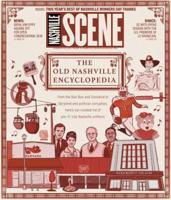One burning history question I've had about Nashville is why, if the Alexander Ewing house is over on Buena Vista Pike, do Ewing family members locate the family graveyard at the corner of Ewing Drive and Knight Drive? White people in the late 1700s and early 1800s tended to keep their dead people close to home.
It turns out that there's an easy explanation for this: the house now known as the Alexander Ewing house is just a house Alexander Ewing owned. The family house was near the cemetery and Ewing Creek, Ewing Drive, Ewingdale Drive, Ewingwood Drive, etc.—the things all named after the family who originally owned the land. The family house no longer stands.
That's a bummer, because Alexander Ewing was one of Nashville's founders. He was an officer under General Greene during the Revolutionary War, where he earned the awesome nickname "Devil Alex." He also earned almost 3,000 acres in Revolutionary War land grants. Perhaps most interestingly, it seems that, for some reason, Alexander Ewing tried repeatedly to keep Frederick Stump from financial ruin, even though Stump's reputation for being a violent lunatic persists. (In all fairness to Stump, pretty much anyone in the 1700s with a reputation for being a violent lunatic, when one looks at his biography, would seem to be suffering from pretty massive PTSD, so Stump may deserve more kindness than local lore has granted him. On the other hand, he really enjoyed slaughtering Indians, so...)
According to the Davidson County Cemetery Survey, the Ewing Family Cemetery was still a cemetery in 2003:
Cemetery surveyors visited the Alexander Ewing Cemetery on January 5, 2003. According the neighbors, the cemetery site had been disturbed about ten years before, when bulldozers entered the grounds and cleared the area. Cuttings, debris and probably remnants of tombstone markers were piled in the center of the lot. This pile was still quite visible on January 5, 2003. According to the neighbors, developers were intending to build a nursing home on the lot, but intervention by the State Archaeologist prevented this plan from taking place on this designated cemetery.The Alexander Ewing Cemetery is listed on the Metro Planning Commission’s web site with Parcel ID and Map.
On January 5, 2003, only one marker was visible on the cemetery site. This marker was fallen. Upper part of marker was intact. Lower part of marker was broken across between Sarah Smith/Ewing.
I went over to the cemetery last Wednesday and it's in worse shape than it was in 2003. No markers remain visible in the grass. There's still a humongous debris pile, but it's so overgrown that I couldn't make out any grave stones. I saw three indentations that might indicate collapsed graves, but they weren't distinct enough for me to say for certain. There's at least some lore to indicate that the Ewing slaves were also buried in this general area (see Carnton for an example of a Middle Tennessee plantation where the slaves and owners all used the same general burial grounds). I checked the parcel map and the cemetery is no longer listed there.
But I couldn't find any indication that any human remains had been moved from the cemetery from 2003 until now. This is not to say that it didn't happen, just that, if it did, I couldn't discover it.
I did discover a big For Sale sign on the land. According to RealTracs, the owners are asking for $500,000 for it.
I asked the folks at the Tennessee Division of Archaeology about the land and it's not exactly clear if the land is still a cemetery. Some Ewings were moved to Mt. Olivet, but there's no record of Alexander or his wife, or weirdly enough, one of their neighbors who was said to be buried in the cemetery, F. B. Drake, ever being moved. And, certainly, if there were enslaved people buried there, it's unlikely they were moved. My understanding from the State, then, is that, without proof that the bodies are no longer there, they still consider it a cemetery and, as far as they know, no one has proven decisively that the lot is empty.
It may be too late to do anything. We may all just be witnessing one more piece of Nashville history passing away. But I keep thinking of the good work the folks at the Buchanan's Station Cemetery did and how they were able to locate graves even without headstones, so it can be done. It just seems to me that, before we pave over it or put a building on it, we should find a way to get a definitive answer as to whether the Ewings are still there.




